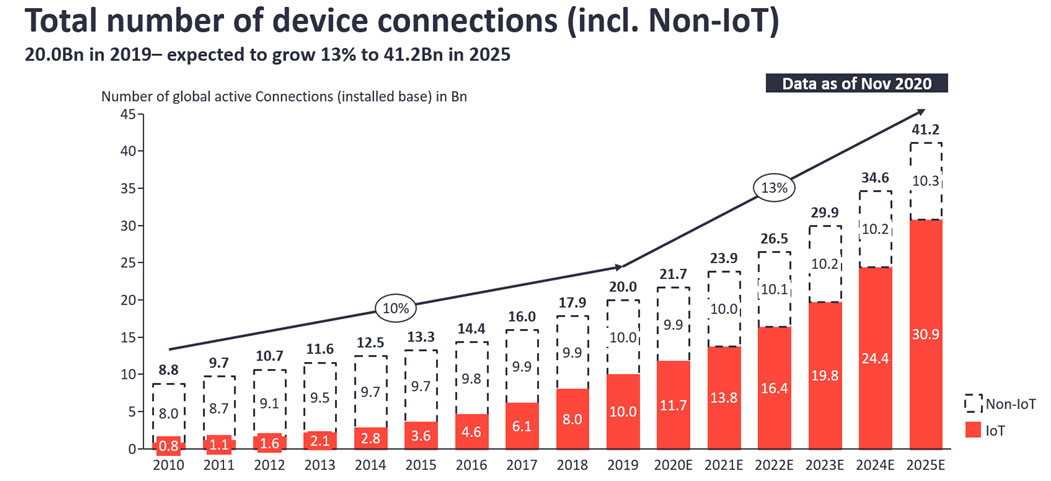by Alok.
IoT Trends in 2021: Is IoT worth the buzz?

Internet of Things (IoT) is a term that has been turning heads since the last few years. But one needs to tread cautiously with fancy terms. Time and again, we have witnessed that they may not, unfortunately, be worth the noise and attention they get.
In this article, we take a hard look at relevant data to decide if it is worth the buzz…..
Where better to begin than with the global trend of number of connected devices, which gives a clear picture of IoT deployments globally. In fact, without looking at applications, one can just observe the chart (given below) with its year-on-year numbers, and they tell you a story.
To summarize: 21.7 billion device connections have been deployed cumulatively as in 2020. To put it in context that’s 2.9 connected devices per person globally! (basis the latest census that estimates a ~7.5 billion world population)

One thing to note though: Every connected device is not an IoT device as per our IoT definition, which results in an important and fundamental question:
What makes an IoT device?
‘IoT Analytics’ defines the Internet of Things as a network of internet-enabled physical objects.
What basically this means is that IoT devices contain independent intelligence. The physical device is connected to a cloud and operates ‘independently’. Smartphones, tablets, laptops, are NOT IoT devices by this definition.
With 11.7 bn pure IoT devices as in 2020, the other key point that we absorb from this chart is the fact that 2020, in fact, has been a milestone year for IoT. This is because for the first time, the number of IoT devices crossed the number of non-IoT connected devices globally.
The acceleration in growth rate (from 10% between 2010 to 2020, to 13%, 2020 onwards) demonstrates the growing spurt in the sector.
So the ‘number of devices’ statistic look encouraging, but is it backed by real revenues and money invested?
For a long time, a consistent criticism to IoT has been its low maturity resulting in low or no monetization. Which means even if devices were being pumped into the ecosystem, the revenue and investments made for them was not substantial. (a business case was not immediately seen by decision makers, etc)
This seems to have taken a turn lately, which signifies maturity in certain segments: Statista boasts that the global IoT market grew from $100bn in 2017 to $212 billion to 2019, and as if that wasn’t enough, suggests it would reach $1.6 tn by 2025.worldwide. Even after rounding down the figures, that’s an estimated growth of approximately 7X in 7 years.
Business Insider is even more bullish, saying the IoT global market will grow to over $3 tn by 2026!
With number of connected devices and revenues presented, here are the sectors that are the growth drivers.

A BCG research report points out that ‘Discrete manufacturing’, ‘Logistics’ and ‘Transportation’ are key sectors for whom ‘the time has come’ with respect to IoT. In fact, 50% of the current overall spending in IoT is from these sectors.
What’s more interesting, is that with time, IoT applications will mature in other sectors like utilities, healthcare, automotive and retail. And hence the sustained year-on-year growth that we saw in the earlier charts.
But what are the end-user applications that are sustaining this growth? And what benefits are users deriving from IoT use-cases?
Based on multiple surveys and research reports, these are the collated key benefits that we distilled out:
Transparency and Easier monitoring:
We can optimize any variable only after we can measure it by some means. One key driver that has boosted applications around IoT is its ability to give visibility to measurement. Be it temperature sensors for boilers, physical location for trucks, vital checks for patients, and more, visibility gives rise to transparency. By the virtue of ‘knowing’ the location of physical assets, organizations can create dashboards which are very handy for monitoring.
Better decisions:
The next step after monitoring is to enable better decision making. From new sets of data, one can take more informed decisions. Output can be then benchmarked against desired outcomes, be it saving costs, increasing efficiency, and so on.
Automating tasks:
One can also automate tasks by rule-based algorithms, as a result of the increased visibility. This is, of course, and extension to better decision making. Only that in this case it is automated rather than manual.
Cut energy cost:
This is a specific outcome increasingly being drawn as a result of IoT implementation, and hence has merit to give a special mention. Through sensors and automated building/ factory management, one can optimize energy costs expended by various activities on real-time data. This optimizes and hence cuts energy costs tremendously.
Predictive maintenance:
This is another area which deserves a special mention. Through sensors, one can increasingly monitor and predict when certain parts of large and complex machinery and infrastructure can fail. Doing this proactively, has found to save a tremendous amount of money and effort.
Increasing engagement:
Finally, with increasingly dynamic output, IoT devices have the ability to engage audiences with intelligent communication. This is, of course, an area we are particularly deep in, and Digital Signage Technology is a space that we see has great potential to build engagement at the point of sale.
Lest we forget, one cannot evaluate an industry in present times, without looking at the implications that the Covid pandemic would have on it.
Overall, we have seen an increase in technology adoption as a result of the pandemic since it helps remote communication and reduces physical contact/ intervention.
The IoT industry too, in the long run, is likely to be enabled as a result of the pandemic. Customers would demand remote deployments and monitoring, which means more devices deployed. However, in the short run, with certain industries largely affected, investments in new technologies may get postponed to a better day. Hence, strained in the short run but favourable in the long term, can be concluded as an outcome of the pandemic.
Finally, we check for ‘side-effects’. IoT at its core may be a boon, but the threats should not outweigh its value. The key area that needs mention here is ‘security’. Data & IT security becomes increasingly important with the many endpoints connected as part of the IT ecosystem, as they can be vulnerable to being exploited.
A Gartner report suggests that more than 25% of identified attacks in enterprises will involve IoT. Their survey indicated that 32% of IT leaders cite security as a top barrier to IoT success.
Cybersecurity is one of the biggest allied industry that will evolve and grow mature as a direct outcome of the growth in IoT. Stringent data & identity protection for assets as well as privacy laws need to be streamlined in the years ahead.
All in all, IoT seems to be worth the attention then?
With tailwinds ripe to steer growth, in the coming years, we will see IoT applications mature and mushroom across varied industries.
And as tech enthusiasts, if we do a bit of crystal ball gazing, I, for one, foresee an exciting journey ahead for us and for our IoT community.
But I leave it to you to take your call, if this is all worth the buzz. 🙂
Sources:




